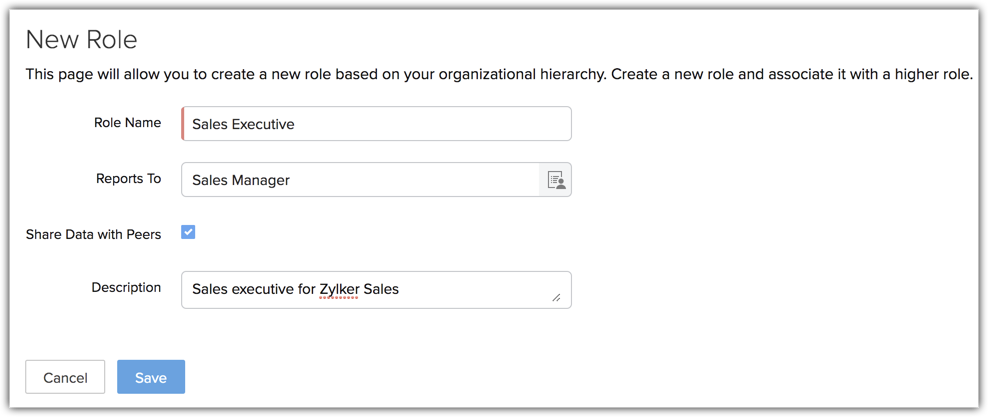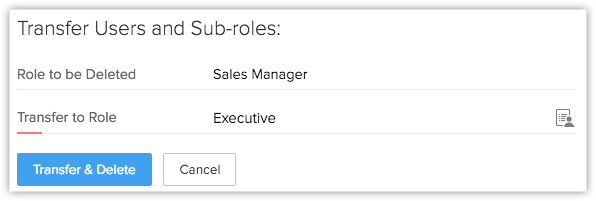In Zoho CRM, you can set up the organization-wide hierarchy using Roles. Users at a higher hierarchy can always access all the records of at a lower hierarchy. For example, a Sales Manager can access all the Sales Reps' records whereas Sales Reps can access only their records.
By default, the CEO and Manager roles are enabled for your Zoho CRM paid account. In addition, you can create different types of roles for users based on their position in your organization hierarchy and the type of your Zoho CRM Edition.

Note
- A user with an Administrator profile will have access to all the data irrespective of the role assigned to the user.
To create new roles
- Go to Setup > Users & Control > Security Control > Roles.
- In the Roles section, click +New Role.
In the New Role page, do the following:
- Enter the Role Name. Do not add a role with the same name.
- Select the immediate superior's role from the Reports To lookup.
If you do not select the superior's role, the new role will be created under the CEO role. - Select the Share Data with Peers check box if you would like to enable access rights to peers.
- Specify the Description for the role.
- Click Save.


Note
- You can create roles only if you have more than one user in your Zoho CRM account.
Assigning Roles to Users
After creating roles, you can assign them to the users in your organization. A user with an Administrator profile will have access to all the data irrespective of the role assigned to the user.
To assign roles to the users
- Go to Setup > Users & Control > Security Control > Users.
- In the Users page, click on a particular <User name>.
- In the User Details page, click the Edit icon.
- In the Edit User page, select a specific Role from the dropdown list.
- Click Save.
Editing Roles
You can modify the user roles as per changes in your organization's hierarchy. As part of the modification of the roles, you can perform the following:
- Rename the role
- Change the Superior Role
- Change the setting for sharing data with Peers
While changing the role names, all the data sharing rules will be updated automatically. So you don't need to calculate the data sharing rules or update the user details.
 Note
Note- A user with an Administrator profile will have access to all the data irrespective of the role assigned to the user.
To edit a Role
- Go to Setup > Users & Control > Roles.
- In the Roles List, click the Role name.
- In the Role Details page, click Edit.
- In the Edit Role page, update the new properties for the role.
- Click Save.

Deleting Roles
You cannot delete the existing roles without transferring the users to a new role.
To delete a Role
- Go to Setup > Users & Control > Roles.
- In the Roles page, click the Role name.
- In the Role Details page, click Delete.
- In the Delete Role page, click on an existing Role to transfer the child-roles to the selected role.

- Click Transfer & Delete.
Now the role and child-roles are transferred to the new role and a different organization hierarchy is created.
SEE ALSO



 Note
Note